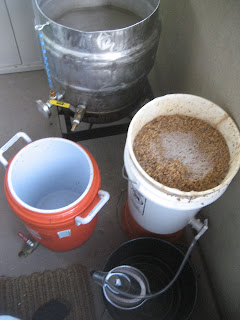I am a huge fan of Belgian Dubbels, so I am still on my quest to perfect this style.
Last year's Dubbel turned out pretty well, but
I had a few improvements I wanted to make.
1. Add oxygen - I still have not made this upgrade, but this batch was aerated by shaking for several minutes and again after 6 & 12 hours.
 2. Use D2 syrup instead of homemade syrup
2. Use D2 syrup instead of homemade syrup - I followed my advice and spent the $6/lb for the real D2 syrup. After one taste of this stuff you can tell there is a difference. It was much more complex and had more of a chocolate than my attempt at making syrup last year. And saved a lot of effort. Here is a good post on trying to
make dark candi sugar at home, if you still want to try.
3. New yeast or different fermentation temperature - I discussed about my yeast choices in the
Belgian Pale Ale post. I used the washed and measured WLP 575 yeast to brew this batch. I really think the more restrained fruity esters will help bring out the great malt backbone that I like. I also pitched at 64 and allowed the beer to free rise into the mid 70s.

Above were the improvements I noted from last year. I also added a few more once reading
Brew Like a Monk and also tasting more examples of the style.
1. Increased the Munich Malt to enrich the Malt Backbone
2. Increased the Aromatic Malt to make the beer a bit more bold
3. Added Flaked Wheat to help with head retention (rocky head on Belgian Beers is very important to me)
4. Used a higher alpha hop to reduce chance of astringency. Plus I lowered the IBUs to help the malt sweetness increase (recommended by Tomme Arthur in the Brew like a Monk book)
5. Used a soft water profile to help reduce astringency and accentuate the malt.
6. Mashed higher at 151 to increase body and malt sweetness.

On to the fun part about Brew Day. I now have my brew system down pretty well. I still always make adjustments if needed for mash temperature or boiling time depending on my extract. But this time it was on another level. I had friends help me brew my last batch and of course I had them do the crappy job of emptying the mash tun. Well, they emptied everything including my copper manifold. It was my fault for not warning them or checking for the manifold after cleaning. I did not realize this until I was just about to mash in for this current batch. So what do I do now?
I have all my ingredients. I have a good block of time. In addition this was my first time trying to brew after work on a weekday. So the homebrew stores are closed plus to make a new manifold would take some time. That's when I remembered I had a paintstraining bag, so I tried a modified brew in a bag method. It worked out, but was difficult because I was already maxing my Mash Tun with 15lbs of grain. My efficiency was a bit low, so I added a bit of table sugar to get my O.G. up higher.
Recipe: Belgian Dubbel 2011
O.G.-1.062 F.G.-1.001 IBU-16
SRM-21 ABV-8% Batch-7 Gal
Grain Bill:
10 lb Belgian Pale Malt (61%)
2 lb Munich Malt 10L (12%)
1 lb Aromatic Malt (6%)
 1 lb Flaked Wheat (6%)
8 oz Caramunich I (3%)
8 oz Special B (3%)
1lb D2 Candi Syrup (6%)
8oz Table Sugar (3%)
Hops:
.35oz Magnum , 13.5%, pellet, 90 min 15.5 IBU
Yeast:
150-200 mL White Labs WLP575 (From Belgian Pale Ale)
1 lb Flaked Wheat (6%)
8 oz Caramunich I (3%)
8 oz Special B (3%)
1lb D2 Candi Syrup (6%)
8oz Table Sugar (3%)
Hops:
.35oz Magnum , 13.5%, pellet, 90 min 15.5 IBU
Yeast:
150-200 mL White Labs WLP575 (From Belgian Pale Ale)
Brew Day:
Brewed: 8/9/11
Water:
see Chart
Mash Details:
H2O/Grain Ratio: 1.3 qt/lb
Mash Volume: 3.67 gal
Sacc Rest. Temp/Time: 151F @ 60min
Strike Temp: 162F
Batch Sparge Volume: 5.5 gal
Sparge Temp/Time: 170F @ 30min
Boil Details:
Boil Volume: 7 gal
Boil Time: 90min
Post Boil Volume: 5.5 gal
Ferment Details:
O.G.: 1.062
Ferment Temp: Pitched at 64 and allowed to free rise 2 degrees/day up into the mid 70s
F.G.: 1.001
This was another 7 gal batch so I can have a 5 gal batch with WLP575 and 2 - 1 gal experiments with dregs from Westmalle Dubbel and Ommegang Dubbel. Those posts will come shortly. First off, they are extremely easy to spot in the spring due to their beautiful and bright colored flowers. (flower picture borrowed from here). And then when the berries are starting to get ripe in late July the leaves turn a nice bright red color.
First off, they are extremely easy to spot in the spring due to their beautiful and bright colored flowers. (flower picture borrowed from here). And then when the berries are starting to get ripe in late July the leaves turn a nice bright red color. 
